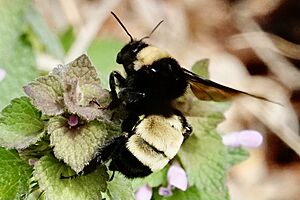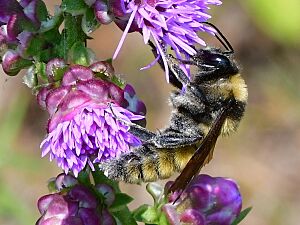American bumblebee facts for kids
Quick facts for kids American bumblebee |
|
|---|---|
 |
|
| Queen in Hanover County, VA | |
 |
|
| Male in Illinois, US | |
| Conservation status | |
| Scientific classification | |
| Genus: |
Bombus
|
| Species: |
pensylvanicus
|
 |
|
| The general range of Bombus pensylvanicus. (Dashed line indicates former range) | |
| Synonyms | |
|
|
The American bumblebee, also known as Bombus pensylvanicus, is a type of bumblebee that lives in North America. It can be found in eastern Canada, much of the Eastern United States, and a large part of Mexico.
This bumblebee used to be very common in the southern United States. However, its numbers have dropped a lot recently. For example, in Pennsylvania, the state it's named after, there are very few left. Overall, the population has gone down by almost 90% in just the last 20 years.
American bumblebees usually live and build their nests in open fields and farmlands. They eat from many different plants, especially sunflowers and clovers. They are very important because they help plants grow by moving pollen, a process called pollination.
Contents
What is the American Bumblebee?
The American bumblebee is a widespread species. It has a long tongue, which helps it reach nectar deep inside flowers. It looks a bit like other bumblebees, but it has a darker color pattern. This bee is mostly found in the eastern United States.
How to Spot an American Bumblebee
Here are some ways to identify an American bumblebee:
- It has a yellow back on its thorax (the middle part of its body).
- Its rear end is black.
- It has three stripes on its abdomen (the back part of its body) that switch between black and white.
- It has a long, thin face.
- Its hair is short.
These features can sometimes make it look like other bumblebee species. A queen American bumblebee is larger, measuring about 22–26 millimeters (about an inch). A worker bee is smaller, around 13–19 millimeters.
How Far Do They Travel?
Bumblebees usually look for food close to their nests. However, American bumblebees have been seen returning to their nests from as far as 1.5 miles away! They likely find their way back by trying different paths until they get home. Male bees become more common later in the summer.
Where Do American Bumblebees Live?
The American bumblebee lives from the Eastern Great Plains across the eastern and central United States, southern Canada, and Mexico. Sadly, this species is becoming rarer. Its numbers are especially low in the northern parts of its range.
Nesting Habits
Bombus pensylvanicus often builds its nests in fields with tall grass. Sometimes, they might even nest underground. They use bundles of hay or long grass to create safe nests above the ground. They can also use existing holes or burrows, like old bird nests, rodent tunnels, or even cinder blocks. Some have even been found nesting in human-made places like buckets and barns!
The Life of a Colony
The American bumblebee colony goes through a cycle, much like other bumblebee species. This cycle depends on the environment and how much food is available. It usually starts in February and ends around November or December.
Starting a New Colony
- In late summer (July/August), a male bee mates with a newly hatched queen.
- The fertilized queen then goes into hibernation for the winter. She waits for spring to find the perfect spot for a new nest.
- Around March, the queen wakes up. She collects pollen and nectar for food and builds a wax pot. This is how she starts her new colony.
- The first female worker bees develop from the eggs laid by the queen. These eggs are fertilized from the male bees of the previous year.
- The queen keeps the eggs warm at first. Then, the eggs grow into larvae, then pupae, and finally, adult female workers. This whole process takes about 4–5 weeks.
Growing the Colony
- The first worker bees go out to find food and bring it back to the nest. This helps the colony grow bigger.
- Workers that hatch later in the summer tend to be larger than the first ones.
- By late summer, a hive can have more than 200 worker bees!
- When the hive is big enough, the queen stops making a special chemical. This chemical usually stops other female bees from laying eggs. When she stops, some female workers can start laying their own eggs.
- However, the queen usually destroys any eggs laid by workers. This creates a constant struggle between the queen and her workers.
- This struggle continues until late summer, when the workers may even sting the queen to death.
- The cycle then begins again in the winter as new queen bee eggs hatch, and the old worker bees die off.
Who Are Their Enemies?
Even though American bumblebees have bright colors to warn predators and a stinger to defend themselves, they still face many dangers. Predators often attack their nests to get the rich food inside, like nectar, larvae, and pollen.
Predators of Bumblebees
- Mammals: Animals like skunks, bears, and raccoons often try to get into bumblebee hives.
- Birds: Some birds eat bumblebees for food.
- Insects: Foraging bees (those out looking for food) are often caught by other insects.
- Crab spiders and ambush bugs hide on flowers and jump out to catch bees.
- Robber flies look like bumblebees. They grab bees, inject them with a special liquid, and then eat their insides. One type, Mallophora bomboides, specifically hunts American bumblebees and even mimics their look!
- Wasps, like the beewolf Philanthus bicinctus, catch bees, paralyze them with venom, and use them to feed their own young.
- Assassin bugs and dragonflies also hunt bumblebees.
Tiny Invaders: Parasites
Bumblebees can also be hosts to tiny organisms called parasitoids. These are creatures whose young grow inside a living host.
- Flies: Many bumblebees are infected by flies. The fly attaches to the bee while it's flying and lays its eggs inside the bee. The fly larva then hatches and eats the bee's tissues. The bee usually dies after about two weeks. The fly then turns into a pupa and spends the winter inside the dead bee, emerging the next year.
- Cuckoo Bumblebees: The American bumblebee can be a host to a "cuckoo" bumblebee species called B. variabilis. These bees lay their eggs in another bee's nest, letting the host bee raise their young.
- Nematode Worms: A tiny worm called Sphaerularia bombi can infect hibernating queen bumblebees. This worm doesn't kill the queen, but it makes her unable to have babies. Infected queens also start looking for food later in the spring.
- Microorganisms: Tiny germs like protozoans and fungi can also live inside bees. They eat the bee's tissues or gut contents. This makes it harder for the bee to find food, shortens its life, and weakens the whole colony.
- Mites: Tracheal mites (Locustacarus buchneri) live in the bee's breathing tubes, making it harder for them to fly and find food.
Bees sometimes have helpful bacteria that can protect them from these germs. However, if bees lose their homes or are exposed to pesticides, they become weaker and more likely to get sick. This can lead to the species declining even more.
Bumblebee Look-Alikes
Bumblebees have bright colors and a sting, which helps them avoid being eaten. Other insects copy their look to also avoid predators. This is called mimicry.
- Müllerian mimicry: When two or more harmful species look alike.
- Batesian mimicry: When a harmless species looks like a harmful one.
Many insects mimic the American bumblebee, including various sawflies, day-flying moths (like Hemaris diffinis), beetles, other flies, and even other bees like carpenter bees.
What Do They Like to Pollinate?
Scientists have studied what flowers American bumblebees prefer. For example, they looked at red-flowered Iris fulva and blue-flowered Iris brevicaulis. The bees seemed to like purple-colored hybrid flowers the most. They also tended to visit the closest flowers, even if it meant switching between different types of flowers. This shows that they don't just stick to one type of flower.
Why Are Their Numbers Dropping?
Bumblebee species have been declining a lot since the 1940s and 1960s, and this continues today. The number of American bumblebees has especially dropped in Illinois. This decline happened at the same time as more land was used for farming in the state.
Scientists have studied the genes of American bumblebees from the past and present. They found that there is less movement of genes between different groups of B. pensylvanicus now. This means that bees from one area are not mixing with bees from other areas as much. While the overall genetic diversity hasn't changed much yet, small losses in genetic diversity can be a sign of a species in trouble. This reduced gene flow could lead to different groups of American bumblebees becoming even more separate in the future.
Current Status
Research shows that the American bumblebee is now uncommon and its numbers are falling quickly. As mentioned, its population has greatly decreased, especially in the northern parts of its range. It used to be the most common bumblebee in the southern United States. Now, it's rare and has even disappeared from some areas.
To help save this species, people are encouraged to support conservation efforts. This includes using wildlife-friendly farming methods, like planting hedgerows and managing pests carefully.


